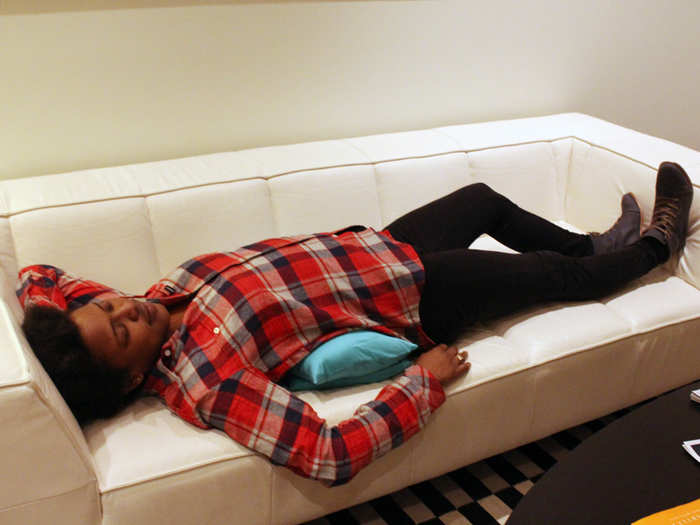
Becoming more powerful starts the night before. It's time to nix the fetal position.
Sleeping on your side with your arms and legs pulled toward your torso is considered a low-power position, Cuddy says. You may wake up feeling sensitive and vulnerable without understanding why, which is not a good way to face a chaotic, competitive workplace.
The power position, which we'll call "The Marissa Mayer," makes you feel bigger and, therefore, more powerful. You can also put your hands behind your head (á la, Marissa Mayer in her Vogue photo spread), which is a power pose that Cuddy often mentions in her talks.

Doing "The Mr. Clean" can help drive home an argument in the boardroom.
Your shoulder posture in this position is pivotal in shaping how observers interpret the folded arms, according to Noah Zandan, president of communications-analytics company Quantified Impressions.
If the shoulders are rolled forward, others will interpret the arms as a sign of weakness, sending the message that you're scared. But if you roll those shoulders back and hold your head high, the crossed arms become a signal of confidence.
While you're at it, Cuddy says it's important when you raise your hand to extend your arm fully, taking up space, as opposed to resting the elbow on the table. Women tend to bend at the arm more than men.

As you're rounding the last bend of your presentation and preparing to deliver the bottom-line offer, command the room with a position Cuddy calls "The Loomer." Leaning forward while standing shows you're engaged and in a position of dominance.
Cuddy named this pose in tribute to Lyndon B. Johnson. "Johnson was 6'4", and he used his stature very thoughtfully — to intimidate and seduce," she says.

We call this one "The Obama" because the Commander in Chief can often be seen with his feet propped up on the Oval Office desk.
This is a tough one to pull off, but Cuddy assures us that resting your feet on the desk — preferably your own — and placing your hands behind your head can lead you to take more potentially profitable risks, like saying your next Big Idea out loud.

Striking a high-power pose in your interviewer's office could come off as offensive, presumptive, and rude, regardless of how it makes you feel, Cuddy says. Here's the alternative, which she dubs "The Performer" in honor of Mick Jagger.
Before the interview, throw your hands in the air and widen your stance, as if you're soaking in the applause after an encore performance. Do it in the elevator or stairwell on your way up to the office, or in the bathroom before checking in with reception. Hold the pose for two minutes to set those hormonal changes in motion and give you the confidence you need to ace the interview.

"Lean in" by leaning back. It's the perfect way to assert your confidence and comfort level when grilling a job candidate.
This less bro-y rendition of "The Obama" emphasizes opening up the body, while keeping your feet on the ground. Cuddy named it "The CEO" after seeing a photo of Oprah Winfrey looking like a total boss.
Variations include placing your hands behind your head and resting an ankle on the knee.

When your boss joins you in line at the K-cup brewing machine, you may feel your heart quicken as your mind scrambles to come up with a more interesting response to "How was your weekend?"
Channel your favorite superheroine and take what Cuddy calls "The Wonder Woman," a classic crime-fighting pose. Tilt your chin up to maximize the power trip.
This position has the opposite effect of touching your neck, which suggests anxiety or lack of control and is considered the lowest power pose of all.

The latest fad in body language is what photographer Peter Hurley calls "The Squinch."
Hurley's video, which has been seen more than 1 million times, demonstrates how slightly "squinting and pinching" the eyes makes celebrities instantly more photogenic.
"Confidence comes from the eyes," Hurley says. "So does fear." When we make those wide, deer-in-the-headlights eyes, we send a message that we're nervous. But tightening the palpebral ligament — bringing the lower eye lid up — shows your boss you know your worth.
Try pairing the squinch with one of Cuddy's high-power poses for a killer combo.


 I spent 2 weeks in India. A highlight was visiting a small mountain town so beautiful it didn't seem real.
I spent 2 weeks in India. A highlight was visiting a small mountain town so beautiful it didn't seem real.  I quit McKinsey after 1.5 years. I was making over $200k but my mental health was shattered.
I quit McKinsey after 1.5 years. I was making over $200k but my mental health was shattered. Some Tesla factory workers realized they were laid off when security scanned their badges and sent them back on shuttles, sources say
Some Tesla factory workers realized they were laid off when security scanned their badges and sent them back on shuttles, sources say Top places to visit in Auli in 2024
Top places to visit in Auli in 2024
 Sustainable Transportation Alternatives
Sustainable Transportation Alternatives
 Why are so many elite coaches moving to Western countries?
Why are so many elite coaches moving to Western countries?

Copyright © 2024. Times Internet Limited. All rights reserved.For reprint rights. Times Syndication Service.